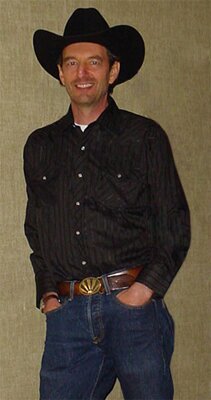Welcome to the “My Place” page
 My name is Scott My name is Scott
I run the Rope and Wire website.
My original idea for this page was to give those living in the country the opportunity to tell others about the things that made their farm or ranch so special.
Well, I’ve come to the conclusion that either no one likes to brag or no one lives on a farm or a ranch. Whatever the case, no one submitted an article so I felt it was high time to try something different.
So for now this will be literally “My Place.” I’ll use this page to post a western blog or short articles. They will either be mine, or possibly one from a contributing R&W community member.
The theme will remain Western but the content will change weekly, or there about.
If you click on any of the links to past blog's, you can return to this page by clicking on the My Place button across from my picture.
I hope you enjoy it but if not, might I suggest you “stroll the grounds.” Read a story or watch a movie.
Thanks for visiting.
Scott
What's yer brand?
Many good Western novels have been written over the years involving cattle in one way or another. From good ol’ cattle drives to no account cattle rustlers, and everything in between, cows have always been synonymous with the old West. Back in the day, the life-blood of any western ranch was its cattle and if you had em’ you had better brand em’. Like the title papers to your favorite truck, the brand on a cow is proof of ownership. Ranches were known by their brand and when a cowboy rode for a ranch, he rode for the brand. So you can bet there was a fair amount of pride involved in being associated with a certain brand.
Branding cattle was probably the single most important function on a working cattle ranch in the old west. But branding didn’t start there. No, branding livestock has been carried out for thousands of years. In fact, modern day grave robbers…aaah, strike that, I meant to say archaeologists, (yes, they do dig up more than just graves), have found paintings on Egyptian tombs over four thousand years old that show scenes of cattle being branded.
Branding livestock is still done today. A branded cow, or horse for that matter may be a stockman’s only claim to ownership. It’s not only extremely important, these days it’s required by law, especially if you have cattle on the open range. That’s right, the law requires ranchers to mark their cattle with a registered brand, using a branding iron.
These days, there is another way to prove ownership of cattle. It’s through the practice of ear notching and wattling. It has, over the years, become what’s known as a customary law that is based on traditional usage. But that’s another topic, for now, we’ll stick with branding.
Identifying brands on cattle is usually quite simple, unless of course the irons are applied carelessly or improperly, then it can be more difficult.
Branding is usually done twice a year. In the spring after calving and in the fall after the cattle have been driven to their winter range.
The branding iron itself has to meet certain requirements. It has to be about one-eighth to one-quarter inch thick. Thinner irons would slice through the hide and injure the animal, and wider irons would dull the design.
Branding is traditionally done on the cow’s left hip.
Why the left hip?
There’s a very scientific reason for that. Buckaroos who throw a loso with their right hand will come up alongside a cow on the left side and check the brand before they throw. No sense wasting a good throw if the cow isn’t theirs.
So how do you read a brand?
Well, the first thing you need to know is that a brand may consist of numbers, letters, characters or symbols in any combination. Brands are read from top to bottom and left to right. There is also some terminology involved. For instance, if a letter is on it’s side, it’s called “lazy.” Short bars at the bottom of the letter or symbol make it “Walking,” If a letter rests in a quarter-circle it’s "rocking."
There have been other modifications done to brands to make them “Flying”, “Tumbling”, “Running” and more.
If you should have a need to trace a certain brand, your county records department should have a brand records book dating back to the organization of the county.
There are also various types of brands that a rancher might use to identify his own critters, so study up. I’ll post a quiz in the January issue of “Over the Fence,” the monthly newsletter of Rope and Wire.com. If you haven’t subscribed yet, why not do so now? There will be a great interview with Western Author Terry Burns this month as well.
I would also like to extend a very Merry Christmas to all of you who read this site. It’s because of you (who read and submit content) this site is so successful. Please consider sending an eCard or a link to a friend or relative this Christmas season.
|